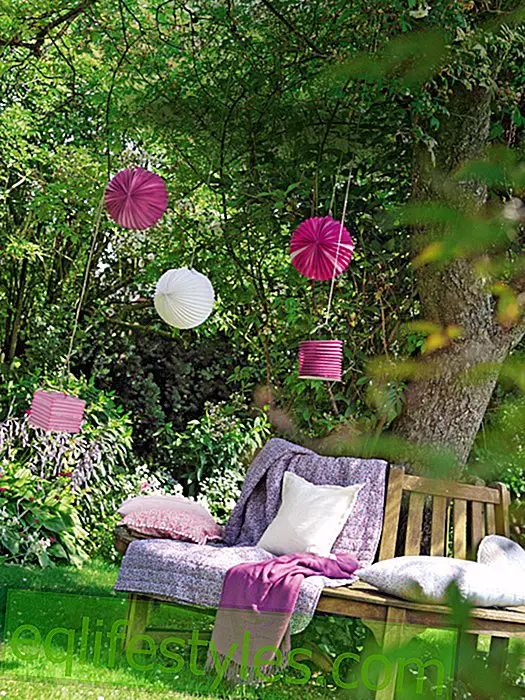
Photo: Jan Rickers
- The Mindfulness Experiment by Ulrike Fach-Vierth
- 1st week: The breath - a strong ally in the self-healing process
- 2nd week: Being in the body - the body-scan method
- Week 3: Walking meditation - deliberately putting one step ahead of the other
- Conclusion: why the fears dwindle, if we are careful
The Mindfulness Experiment by Ulrike Fach-Vierth
After she is diagnosed with multiple sclerosis, author Ulrike Fach-Vierth discovers the source of healing and power of mindfulness. She starts a 3-week program ...
The happinez author Ulrike Fach-Vierth has learned through mindfulness meditation to pause and realize that every moment can be our teacher.
When my neurologist told me the diagnosis of multiple sclerosis in a nutshell and objectivity, he said that I could do nothing in my chronic creeping variant except physiotherapy to influence the course.
The American molecular biologist Jon Kabat-Zinn says otherwise: "From our point of view, as long as you breathe, you have more healthy than sick parts, no matter what's wrong with you." and "Much of what is healthy in us is either ignored, neglected, or taken for granted. Mindfulness meditation energizes these healthy parts of you in the form of targeted attention, thereby strengthening your self-healing powers and the path to healing and health is being broken. "
Healing, in his opinion, does not necessarily mean recovery from illness. Even if we do not get well, we can always experience healing by changing our attitude to illness and pain and learning to see with the eyes of wholeness. Being attentive means not paying attention to everything and seeing things as they are. Healing therefore requires receptivity and acceptance.
To learn more about the healing and power source of mindfulness, I am beginning to read Jon Kabat-Zinn's standard work "Healthy through Meditation" (available here on Amazon) for the second time. Here I come across a three-week "Mindfulness-Based Stress Reduction" - MBSR program, which he recommends as an introduction to the mindfulness meditation for the home. "Their determination is of utmost importance, " writes Kabat-Zinn. I'm determined to start the program and keep it up.
1st week: The breath - a strong ally in the self-healing process

Photo: Jan Rickers
I sit on my yoga mat, my eyes closed, trying to focus on my breath for fifteen minutes, raising and lowering the abdominal wall.
Which is not so easy, because countless thoughts go through my head. Every time I notice that my concentration is released from the breath, I should just observe it, not evaluate it, not think, "But now I have to concentrate on my breath." So, I'm just registering the activity in my mind to once again focus my attention on my breathing.
"Moments of mindfulness are moments of peace and silence, even in the midst of action, " writes Kabat-Zinn. "When your entire life is determined by activity, the regular meditation exercise can be a space for mental recovery that you can take refuge in to balance and rebalance." In fact, on the seventh day of my first week of training, I feel that the morning meditation curbs my headless activity, and that I find myself in an unfamiliar state of relaxation.
2nd week: Being in the body - the body-scan method

Photo: Jan Rickers
"Once we focus our energies on really feeling our bodies and guard against falling into judgmental thinking about the body, all of our bodily experience and experiencing ourselves can radically change, " writes Jon Kabat. Tin.
In the second week of my mindfulness experiment, 45 minutes of body-scan meditation are on the program every day. I lie on my mat on the ground and walk with the attention through the whole body. I start with the little toe in the left foot, then turn to the sole of the foot, the heel, the back of my foot and the ankle as I breathe in and out of every little area and look out for all the sensations I feel, So I taste my whole body and try to become one with every part of the body I call my attention to.
And in part, I manage that, which fills me with a whole new, happy body feeling. I suddenly realize how incredibly complex my body is, what diverse capabilities it has and how wonderful it is to have it, no matter what it looks like and in what condition it is. As a result, doing body scans for me day by day becomes more of a way to be in the body and with me, a way to be whole now, right now.
Week 3: Walking meditation - deliberately putting one step ahead of the other

Photo: Jan Rickers
Strictly speaking, everything the body does is amazing. We rarely spend time looking at it.
Walking is a good example. Because I have involuntarily come into the situation of not being able to walk correctly, I know what precious and wonderful ability walking is. It is no different with seeing, hearing, speaking, breathing, thinking. And through the conscious perception of the moment, everything becomes a teacher: the signals of the body and the mind, every pain, every joy.
Kabat-Zinn defines mindfulness as a state of consciousness in which we deliberately focus our attention on all those things we usually never think about.
A good way to practice mindfulness in everyday life is walking meditation, which is the subject of my third week of training. As the name implies, I now turn every day all the attention to my gait and all the associated sensations. It does not matter if I am in the woods with the dog or on my way to the supermarket. First, I try to consciously feel myself putting one foot down on the ground and shifting my weight towards it, then lifting the other foot, moving on a bit further, and also sitting on the ground.
When I notice that my mind is free of the perception of the feet and legs, I'll just bring it back. And now it works pretty well. Walking meditation is about being present in each step. The trick is to be completely there - not in the sense of there, but from here.
Conclusion: why the fears dwindle, if we are careful

Photo: Jan Rickers
Towards the end of my last week of meditation, I realize that the mindfulness exercise is hard work too, and I've always had periods in which I had to pull myself together to keep going, especially when there were no successes for several consecutive days.
"Mindfulness is not a bulldozer, with which you simply flattens every resistance, " says Jon Kabat-Zinn. "Instead, it gently shakes our barriers, here and there a little bit - and as they start to totter, new dimensions of being open up, even in the midst of doubt and pain." It always requires a personal vision to consolidate the decision for a meditation practice and to maintain it for months and years.
That self-healing or at least inner peace can be found through meditation is shown by a study by the University of Wisconsin. The researchers discovered that with increasing meditation practice, the activity pattern of certain brain parts above the forehead, which are important for the processing of negative feelings, increases. The higher the activity in this region, the better our ability to deal efficiently with adverse events and stress, perhaps the most important pillar of our health.
Of course, after three weeks of mindfulness exercises, no neuronal changes have yet occurred. Has changed something more in my interior. As if I were entering a new landscape of which I had at most a vague idea and which holds an inexhaustible source of positive energy, which I can use for my healing.
I want to become familiar with this landscape and become at home in it, which is why I choose to extend my mindfulness experiment indefinitely. Full of curiosity about what resources I will come across in the depths of my being. "
***
More about this topic can be found in the Happinez booklet "Mindfulness" - available in stores and in the Happinez Webshop
Would you like to subscribe to Happinez? Click here for the subscription shop!
More from the Mindstyle magazine Happinez is also available on Facebook.










